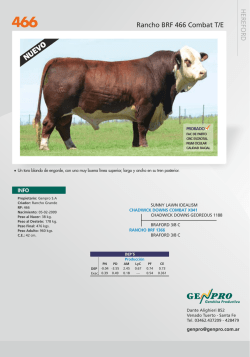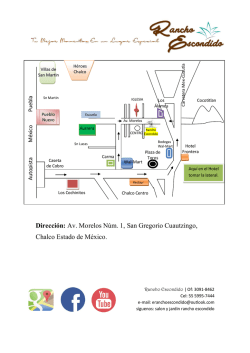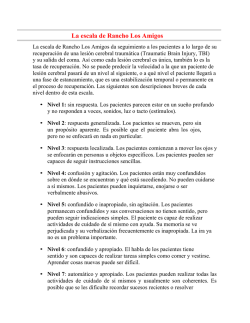
Orthoptera - Dugesiana - Universidad de Guadalajara
Dugesiana, Año 22, No. 2, Julio-Diciembre 2015, es una publicación Semestral, editada por la Universidad de Guadalajara, a través del Centro de Estudios en Zoología, por el Centro Universitario de Ciencias Biológicas y Agropecuarias. Camino Ramón Padilla Sánchez # 2100, Nextipac, Zapopan, Jalisco, Tel. 37771150 ext. 33218, http://dugesiana.cucba.udg.mx, [email protected]. Editor responsable: José Luis Navarrete Heredia. Reserva de Derechos al Uso Exclusivo 04-2009-062310115100-203, ISSN: 2007-9133, otorgados por el Instituto Nacional del Derecho de Autor. Responsable de la última actualización de este número: Coordinación de Tecnologías para el Aprendizaje, Unidad Multimedia Instruccional, M.B.A. Oscar Carbajal Mariscal y José Luis Navarrete Heredia. Fecha de la última modificación 14 de diciembre 2015, con un tiraje de un ejemplar. Las opiniones expresadas por los autores no necesariamente reflejan la postura del editor de la publicación. Queda estrictamente prohibida la reproducción total o parcial de los contenidos e imágenes de la publicación sin previa autorización de la Universidad de Guadalajara. Dugesiana 22(2):97-99 Fecha de publicación: 14 de diciembre 2015 ©Universidad de Guadalajara ISSN 1405-4094 (edición impresa) ISSN 2007-9133 (edición online) Nota Científica First Records of Aztecacris gloriosus (Hebard, 1935) (Orthoptera: Acrididae) for México Primeros registros de Aztecacris gloriosus (Hebard, 1935) (Orthoptera: Acrididae) para México Robert A. Behrstock* and Thomas R. Van Devender** * 10359 S Thicket Place, Hereford, AZ 85615 USA, [email protected]; **GeaterGood.org, 6262 N. Swan Rd., Suite 150, Tucson, AZ 85718 USA, [email protected] Hebard (1935) described Perixerus gloriosus from specimens taken during the 1920s in the Atascosa Mountains, Santa Cruz County, Arizona, U.S.A. Roberts (1947) erected the genus Aztecacris for gloriosus and two similar Mexican species. Ball et al. (1942) briefly summarized dates for eggs and adults, known food plants, and distribution. Helfer (1987) suggested the species’ apparent absence was due to drought. A. gloriosus was not recorded for ca. 70 years, but was recently rediscovered in its historic range (Behrstock and Sullivan 2012). Inquiries to collections with extensive holdings of grasshoppers failed to produce records of A. gloriosus from México (Behrstock and Sullivan 2012; E. Mariño-Pedraza pers. comm. 9 Oct 2013). We present these records as the first for the country. Rancho Las Avispas (lat. 31.19278° N, long. -111.10139° W, 1,222 m elev.) is located in the Sierra Las Avispas, Municipio de Nogales, Sonora, México, and is 15 km (by air) WSW of Nogales, Arizona. The ranch headquarters is situated in a west-flowing canyon that eventually feeds into the Río Asunción/Altar at La Arizona, Sonora. The ranch’s owner, John Ochoa, has hosted many scientists who have performed biological inventories on the site and neighboring ranches. Prior to a visit in September, 2013, Van Devender asked Ochoa to look for a colorful grasshopper known only from nearby mountains in the U.S. Subsequently, Ochoa found several of these grasshoppers just outside the ranch headquarters. From 28-30 September 2013, we were part of a group of 10 scientists who visited Rancho Las Avispas. The excursion was organized by Van Devender as part of the Madrean Archipelago Biodiversity Assessment (MABA) of Sky Island Alliance (Tucson, AZ). By the end of the weekend, most participants had encountered one or more A. gloriosus in the vicinity of the ranch headquarters. The habitat was a narrow canyon bottom with an open woodland of Arizona oak (Quercus arizonica), Mexican blue oak (Q. oblongifolia), and Emory oak (Q. emoryi) with scattered velvet mesquite (Prosopis vetulina) and netleaf hackberry (Celtis reticulata). Understory plants included a dense growth of slimleaf bursage (Ambrosia confertiflora), as well as beggar tick (Bidens sp.), scarlet spiderling (Boerhavia coccinea), Apache plant (Guardiola platyphylla), and Peruvian zinnia (Zinnia peruviana). As the group left the ranch, several party members investigated the roadside a bit further east at Rancho Diamante. The site (lat. 31.16889° N, long. -111.07833° W, 1,481 m elev.) is a steep, rocky slope with Emory oak, silverleaf oak (Quercus hypoleucoides), and alligator juniper (Juniperus deppeana). Understory plants included Thurber’s desert peony (Acourtia thurberi), pointleaf manzanita (Arctostaphylos pungens), desert broom (Baccharis sarothroides), red barberry (Berberis haematocarpa), datura (Datura sp.), Arizona wild cotton (Gossypium thurberi), evergreen sumac (Rhus virens), and sunflower goldeneye (Viguiera dentata) (Chris Roll and Behrstock pers. obs.). At this site, Richard Bailowitz (Tucson, AZ) found ca. eight A. gloriosus in both well-lit and shaded areas and was unable to associate them with any particular plant (R. A. Bailowitz pers. comm. 6 Oct 2013). Based upon voucher specimens, photos taken by group members, and personal observations, at least 40 A. gloriosus were present within ca. 100 m of the Rancho Las Avispas ranch house including three pairs in copula (Fig. 1) and one nymph (Fig. 2). The nymph, a final instar female, differed from adults as follows: yellow on the lateral areas of the head, pronotum, and abdomen; light and dark gray banding on the outer face of the hind femur; broadly black on the dorsum of the abdomen; and two large black spots behind the eye. Other grasshoppers present at the site were Brachystola magna (Girard), Taeniopoda eques (Burmeister), Schistocerca nitens (Thunberg), Aidemona azteca (Saussure) nymphs only, Barytettix humphreysii (Thomas), Conalcaea huachucana Rehn, Melanoplus aridus/desultorious (Scudder), M. differentialis (Thomas), M. lakinus (Scudder), Boopedon flaviventris Bruner, Syrbula montezuma (Saussure), Arphia pseudonietana (Thomas), and Heliastus benjamini Caudell. Of these, the most numerous were Melanoplus lakinus, Boopedon flaviventris, and Arphia pseudonietana. Observations of these grasshoppers and other insects seen at Rancho las Avispas are available online in the MABA database (www. madrean.org). Previous authors have suggested an association between A. gloriosus and members of the composite family Dugesiana (Asteraceae) including Wright’s baccharis (Baccharis wrightii), desert broom, brittlebush (Encelia farinosa [in error-not in Santa Cruz County]), broom snakeweed (Gutierrezia sarothrae), goldeneye, and perhaps turpentine bush (Ericameria laricifolia) (Ball et al, 1942; Behrstock and Sullivan 2012). Feeding was not observed at Rancho Las Avispas, where slimleaf bursage and beggar tick were abundant and A. gloriosus was numerous. Further east at Rancho Diamante, Bailowitz found A. gloriosus where we observed desert broom and other composites including threadleaf snakeweed (G. microcephala). These composites may have served as food plants We did not encounter A. gloriosus at two sites close to Rancho las Avispas: Arroyo Planchas de Plata, Rancho Esmeralda (= Rancho Las Borregas), 16.2 km (by air) WSW of Nogales, Sierra Las Avispas (lat. 31.21139°N long. -111.12778°W, 1083 m elev.), a rocky canyon with riparian forest and oak woodland; or Cañada Adrián, 16.6 km (by air) WSW of Nogales, Sierra Las Avispas (lat. 31.21722°N long. -111.13389°W, 1081 m elev.), a rocky canyon with riparian forest in an oak woodland-desert grassland ecotone. A. gloriosus is now known from just north and just south of the México-U.S. border. The Rancho Las Avispas population is ca. 27 km south of the closest U.S. records. Due to the small known world distribution of A. gloriosus, we suggest that the species is worthy of protection in the United States and México, and that regulatory agencies monitor its numbers and distribution. Voucher specimens were deposited in the Colección de Entomología, Instituto de Biología, Universidad Nacional Autónoma de México, México City. ACKNOWLEDGMENTS We thank John Ochoa (Tucson, AZ) for his warm hospitality to our group visiting Rancho Las Avispas; Sky Island Alliance (Tucson, AZ) for supporting the excursion that produced these records; Harry U. BrailovskyAlperwitz, Curador de la Coleccion Nacional de Insectos 98 and Curador de Hemiptera (CNIN), Instituto de Biología, UNAM (México City), who generously included Sky Island Alliance researchers on his SEMARNAT collecting permit; and Enrique Mariño-Pedraza, Técnico Académico Titular B, Colección de Entomología (CNIN), Instituto de Biología, UNAM, for searching the collection for specimens of A. gloriosus. Other trip participants who contributed grasshopper records included Rich Bailowitz, Margarethe Brummermann, Charles Hedgcock, Steve Minter, Ana Lilia Reina-G., Chris Roll, and Eric Wallace. LITERATURE CITED Ball E.D., E.R. Tinkham, R. Flock y C.T. Vorhies. 1942. The grasshoppers and other Orthoptera of Arizona. University of Arizona Agricultural Experiment Station Technical Bulletin No. 93: 255-373. Behrstock, R.A. y P.H. Sullivan. 2012. Rediscovery of Aztecacris gloriosus (Hebard, 1935) (Orthoptera: Acrididae): associated plants and orthopterans, and an attempted intergeneric copulation. Journal of Orthoptera Research, 21(2): 251-254. Fontana, P., F.M. Buzzetti y R. Mariño-Pérez. 2008. Chapulines, Langostas, Grillos y Esperanzas de México. Guía fotográfica. WBA Handbooks, 1. World Biodiversity Association, Verona. Hebard, M. 1935. Studies in the Orthoptera of Arizona. Part I: New genera, species, and geographical races. Transactions American Entomological Society, 61(2): 111-153. Helfer, J.R. 1987. How to Know the Grasshoppers, Crickets, Cockroaches and their Allies. Dover Publications, Inc., New York. Roberts, H.R. 1947. Revision of the Mexican Melanoplini (Orthoptera: Acrididae: Cyrtacanthacridinae) Part 1. Proceedings Academy Natural Sciences Philadelphia, 99: 201-230. Recibido: 24 de agosto 2015 Aceptado: 23 de septiembre 2015 First Records of Aztecacris gloriosus (Hebard, 1935) (Orthoptera: Acrididae) for México 1 2 Figure 1. Aztecacris gloriosus pair in copula. Rancho Las Avispas, Sonora, México. 30 September 2013. Robert A. Behrstock/ Naturewide Images. Figure 2. Aztecacris gloriosus female nymph. Rancho Las Avispas, Sonora, México. 30 September 2013. Robert A. Behrstock/Naturewide Images. 99 Dugesiana 100
© Copyright 2025



